ធ្នូ . 01, 2024 19:40 Back to list
basket strainer
Understanding Basket Strainers Key Components and Applications
Basket strainers are essential devices widely used in various industries to protect expensive machinery and maintain the efficiency of fluid systems. These strainers are designed to catch and remove unwanted particles from fluids, whether they are liquids or gases. This article delves into the workings, applications, and benefits of basket strainers.
What is a Basket Strainer?
A basket strainer is a type of filtration device that features a basket-shaped perforated or mesh screen, typically made from stainless steel or plastic. The design allows for efficient flow and separation of solids from liquids. As the fluid enters the strainer, it passes through the mesh, which captures debris, dirt, and other contaminants while allowing clean fluid to exit through the outlet.
The mesh screen’s size and shape can vary considerably depending on the specific application requirements. Common mesh sizes range from 20 to 400 microns, allowing manufacturers to customize the strainer to meet the desired filtration needs.
How Does a Basket Strainer Work?
The operation of a basket strainer is relatively straightforward. When fluid flows through the inlet, it encounters the mesh screen inside the basket. The screen traps particulates while allowing the clean fluid to pass through the perforations. Over time, as more particulates are collected, flow rates may decrease, prompting the need for cleaning or maintenance.
Basket strainers can be designed for easy maintenance, often featuring a lid or removable top that allows for quick access to the basket. This ease of maintenance is one of the significant advantages of basket strainers, as it ensures minimal downtime during cleaning or replacement procedures.
basket strainer

Applications of Basket Strainers
Basket strainers have a wide array of applications across different sectors. They are widely used in
1. Water Treatment Plants Ensuring that pipes, pumps, and valves remain free from debris that can disrupt operations. 2. Chemical Processing Removing solids from corrosive chemicals, thus protecting essential equipment and extending its life. 3. Oil and Gas Straining crude oil, natural gas, and other fluids during extraction to prevent damage to pumps and compressors. 4. Food and Beverage Maintaining cleanliness in manufacturing processes by filtering out unwanted particles from ingredients. 5. HVAC Systems Protecting heating, ventilation, and air conditioning systems from obstructions that can lead to inefficiencies.
Advantages of Using Basket Strainers
The benefits of incorporating basket strainers into a system are manifold
- Protection of Equipment By filtering out harmful particles, basket strainers help to prolong the lifespan of pumps, valves, and other machinery. - Cost Efficiency Proper filtration minimizes maintenance costs and decreases the likelihood of costly repairs. - Flow Consistency Maintaining consistent flow rates is critical in many industrial processes, and basket strainers can help achieve this by preventing blockages. - Easy Maintenance The design allows for straightforward access, making maintenance processes quicker and less labor-intensive.
Conclusion
Basket strainers are indispensable in ensuring system efficiency and longevity across various industries. Their simple yet effective design enables them to provide crucial filtration, protecting equipment from damage caused by debris and solids. As industries continue to prioritize maintenance efficiency and operational longevity, the reliance on basket strainers is likely to grow, making them a staple in fluid management systems worldwide. Their versatility and ease of use reinforce their value, proving that in the world of industrial applications, the simplest solutions can often yield the most significant benefits.
Share
-
Y Strainers: Protecting Your Pipes with PrecisionNewsAug.27,2025
-
Wafer Type Butterfly Valves: Reliable Flow Control SolutionsNewsAug.27,2025
-
Wafer Type Butterfly Valves: Essential Components for Efficient Flow ControlNewsAug.27,2025
-
Reliable Flow Control with High-Quality Check ValvesNewsAug.27,2025
-
Reliable Flow Control with Gate ValvesNewsAug.27,2025
-
Innovative Check Valves for Reliable Flow ControlNewsAug.27,2025


